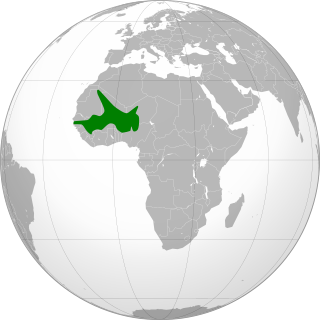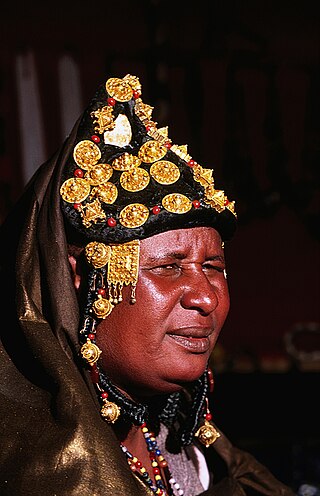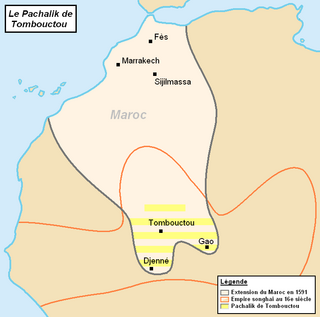| Total population | |
|---|---|
| 1,000 [1] | |
| Regions with significant populations | |
| Timbuktu | |
| Languages | |
| French, Arabic, Ladino | |
| Religion | |
| Judaism |
| Part of a series on |
| Jews and Judaism |
|---|
The history of the Jews in Mali dates back to the 8th century CE. Today, around 1,000 descendants of Jews live in Mali, mostly in or near Timbuktu.
The Jewish history of Mali begins in the 8th century, when multi-lingual African-Jewish Radhanites first settled in Timbuktu in the Songhai Empire. These medieval merchants established a trading center in the city, from which a network of trading routes were created through the desert.
After 1492, more Jews arrived in Mali following the Expulsion of Jews from Spain. During the 14th and 15th centuries, Sephardi Jews settled in Timbuktu from Portugal and Spain. In 1492, Askia Muhammad I, the ruler of the Askiya dynasty of the Songhai Empire, threatened Jews with death if they refused to convert to Islam. While some Jews chose to convert to Islam, the majority fled. In 1526, the Berber Andalusi historian Leo Africanus described the ruler's persecution of the Jewish community: "The king (Askia) is a declared enemy of the Jews. He will not allow any to live in the city. If he hears it said that a Berber merchant frequents them or does business with them, he confiscates his goods."
In 1496, a Jewish community was founded at Tindirma by Iberian Sephardi Jews who had been expelled from Spain and Portugal. [2]
In 1860, the Moroccan Rabbi Mordechai Abi Serour settled in Timbuktu along with several other Moroccan Jews in order to engage in trading. The rabbi was able to negotiate with local authorities to gain a protected status for the community. The community was able to establish a new synagogue in Timbuktu, as well as a Jewish cemetery.
By the early 1900s, no organized Jewish community remained in Mali.
In 1963, the ethnic consciousness of Jewish descendants living in Tindirma was revived after local fishermen wanted to build a village on top of the remains of Al Yahudi Cemetery, causing local Jews to rise up in strong opposition. [3]
In the 1990s, a revival of Jewish identity began in Timbuktu, as "Hidden Jews" began to reconnect with their Jewish roots. These Malians of Jewish descent are predominantly Muslim. Ismael Diadie Haidara, an historian from Timbuktu, established founded Zakhor (Timbuktu Association for Friendship with the Jewish World), an organization of Malians of Jewish descent, most of whom are Muslims. The organization, and others of Jewish descent in Mali, have worked to uncover Mali's forgotten Jewish history that had previously been concealed in order to avoid persecution. [4] In 1996, Zakhor published a manifesto declaring themselves Jews and declaring themselves the descendants of the Jews of Tuat, a region at the edge of the Sahara in western Algeria. [5]

Sephardic or SephardiJews, also Sephardim or PeninsularJews, are a Jewish diaspora population associated with the Iberian Peninsula. The term, which is derived from the Hebrew Sepharad, can also refer to the Mizrahi Jews of Western Asia and North Africa, who were also influenced by Sephardic law and customs. Many Iberian Jewish exiles also later sought refuge in Mizrahi Jewish communities, resulting in integration with those communities.

Timbuktu is a city in Mali, situated twenty kilometres (12 mi) north of the Niger River. The town is the capital of the Tombouctou Region, one of the eight administrative regions of Mali and one town of Songhai people, having a population of 54,453 in the 2009 census.

The Songhai Empire was a state located in the western part of the Sahel during the 15th and 16th centuries. At its peak, it was one of the largest African empires in history. The state is known by its historiographical name, derived from its largest ethnic group and ruling elite, the Songhai people. Sonni Ali established Gao as the empire's capital, although a Songhai state had existed in and around Gao since the 11th century. Other important cities in the kingdom were Timbuktu and Djenné, where urban-centred trade flourished; they were conquered in 1468 and 1475, respectively. The Akan state of Bonoman was located to the south of the empire. Initially, the Songhai Empire was ruled by the Sonni dynasty, but it was later replaced by the Askia dynasty (1493–1901).

The Songhai people are an ethnolinguistic group in West Africa who speak the various Songhai languages. Their history and lingua franca are linked to the Songhai Empire which dominated the western Sahel in the 15th and 16th century. Predominantly a Muslim community, the Songhai are found primarily throughout Niger and Mali in the Western sudanic region. The name Songhai was historically neither an ethnic nor linguistic designation, but a name for the ruling caste of the Songhay Empire which are the Songhai proper of sunni and Askya dynasty found predominantly in present-Niger. However, the correct term used to refer to this group of people collectively by the natives is "Ayneha". Although some Speakers in Mali have also adopted the name Songhay as an ethnic designation, other Songhay-speaking groups identify themselves by other ethnic terms such as Zarma or Isawaghen. The dialect of Koyraboro Senni spoken in Gao is unintelligible to speakers of the Zarma dialect of Niger, according to at least one report. The Songhay languages are commonly taken to be Nilo-Saharan but this classification remains controversial. Nicolai considers the songhay languages as a afro-asiatic Berber subgroup or a new subgroup of semitic languages restructured under Mande and nilo Saharan influence, the lexicon of songhay languages includes many completes lexical fields close to Berbers languages, old and new semitic, northern songhay speakers are Berbers from Tuareg people : Dimmendaal (2008) believes that for now it is best considered an independent language family.

African Jewish communities include:

Maghrebi Jews or North African Jews are ethnic Jews who had traditionally lived in the Maghreb region of North Africa under Arab rule during the Middle Ages. Established Jewish communities had existed in North Africa long before the arrival of Sephardi Jews, expelled from Portugal and Spain. Due to proximity, the term 'Maghrebi Jews' sometimes refers to Egyptian Jews as well, even though there are important cultural differences between the history of Egyptian and Maghrebi Jews. These Jews originating from North Africa constitute the second largest Jewish diaspora group.

Askia Muhammad I, born Muhammad ibn Abi Bakr al-Turi or Muhammad Ture, was the first ruler of the Askia dynasty of the Songhai Empire, reigning from 1493 to 1528. He is also known as Askia the Great, and his name in modern Songhai is Mamar Kassey. Askia Muhammad strengthened his empire and made it the largest empire in West Africa's history. At its peak under his reign, the Songhai Empire encompassed the Hausa states as far as Kano and much of the territory that had belonged to the Songhai empire in the east. His policies resulted in a rapid expansion of trade with Europe and Asia, the creation of many schools, and the establishment of Islam as an integral part of the empire.
Taghaza is an abandoned salt-mining centre located in a salt pan in the desert region of northern Mali. It was an important source of rock salt for West Africa up to the end of the 16th century when it was abandoned and replaced by the salt-pan at Taoudenni which lies 150 km (93 mi) to the southeast. Salt from the Taghaza mines formed an important part of the long distance trans-Saharan trade. The salt pan is located 857 km (533 mi) south of Sijilmasa, 787 km (489 mi) north-northwest of Timbuktu and 731 km (454 mi) north-northeast of Oualata.

Azawad, or Azawagh, was a short-lived unrecognised state lasting from 2012 to 2013. Azawagh (Azawaɣ) is the generic Tuareg Berber name for all Tuareg Berber areas, especially the northern half of Mali and northern and western Niger. The Azawadi declaration of independence was declared unilaterally by the National Movement for the Liberation of Azawad (MNLA) in 2012, after a Tuareg rebellion drove the Malian Armed Forces from the region.

The Alhambra Decree was an edict issued on 31 March 1492, by the joint Catholic Monarchs of Spain ordering the expulsion of practising Jews from the Crowns of Castile and Aragon and its territories and possessions by 31 July of that year. The primary purpose was to eliminate the influence of practising Jews on Spain's large formerly-Jewish converso New Christian population, to ensure the latter and their descendants did not revert to Judaism. Over half of Spain's Jews had converted as a result of the religious persecution and pogroms which occurred in 1391. Due to continuing attacks, around 50,000 more had converted by 1415. A further number of those remaining chose to convert to avoid expulsion. As a result of the Alhambra decree and persecution in the years leading up to the expulsion of Spain's estimated 300,000 Jewish origin population, a total of over 200,000 had converted to Catholicism to remain in Spain, and between 40,000 and 100,000 remained Jewish and suffered expulsion. An unknown number of the expelled eventually succumbed to the pressures of life in exile away from formerly-Jewish relatives and networks back in Spain, and so converted to Catholicism to be allowed to return in the years following expulsion.:17

Moroccan Jews constitute an ancient community. Before the founding of the State of Israel in 1948, there were about 265,000 Jews in the country, which gave Morocco the largest Jewish community in the Muslim world, but by 2017 only 2,000 or so remain. Jews in Morocco, originally speakers of Berber languages, Judeo-Moroccan Arabic or Judaeo-Spanish, were the first in the country to adopt the French language in the mid-19th century, and unlike the Muslim population French remains the main language of members of the Jewish community there.
The Wangara are a subgroup of the Soninke who later became assimilated merchant classes that specialized in both Trans Saharan and Secret Trade of Gold Dust. Their diaspora operated all throughout West Africa Sahel-Sudan. Fostering regionally organized trade networks and Architecture projects. But based in the many Sahelian and Niger-Volta-Sene-Gambia river city-states. Particularly Dia, Timbuktu, Agadez, Kano, Gao, Koumbi Saleh, Guidimaka, Salaga, Kong, Bussa, Bissa, Kankan, Jallon, Djenné as well as Bambouk, Bure, Lobi, and Bono State goldfields and Borgu. They also were practicing Muslims with a clerical social class (Karamogo), Timbuktu Alumni political advisors, Sufi Mystic healers and individual leaders (Marabout). Living by a philosophy of merchantile pacifism called the Suwarian Tradition. Teaching peaceful coexistence with non-Muslims, reserving Jihad for self-defence only and even serving as Soothsayers or a "priesthood" of literate messengers for non-Muslim Chiefdoms/Kingdoms. This gave them a degree of control and immense wealth in lands where they were the minority. Creating contacts with almost all West African religious denominations. A group of Mande traders, loosely associated with the Kingdoms of the Sahel region and other West African Empires. Such as Ghana, Mali, Songhai, Bono State, Kong, Borgu, Dendi, Macina, Hausa Kingdoms & the Pashalik of Timbuktu. Wangara also describes any land south of Timbuktu and Agadez. The Bilad-Al-Sudan or Bilad-Al-Tibr, "Land of Black" or "Gold."

Jews of the Bilad al-Sudan describes West African Jewish communities which were connected to known Jewish communities who migrated to West Africa as merchants for trading opportunities. Various historical records state that at one time, they were present in the Ghana, Mali, the Mossi Kingdoms and Songhai empires, which was then called the Bilad as-Sudan a name which is derived from the Arabic term which means Land of the Blacks. In later years Jews who were expelled from Spain, Portugal and Morocco, and who migrated to West Africa, formed communities off the coast of Senegal as well as on the Islands of Cape Verde. These Jewish communities continued to exist for hundreds of years but eventually disappeared as a result of changing social conditions, persecution, migration, and assimilation.
Muhammad ibn Abd al-Karim al-Maghili, commonly known as Muhammad al-Maghili was a Berber 'alim from Tlemcen, the capital of the Kingdom of Tlemcen, now in modern-day Algeria. Al-Maghili was responsible for converting the ruling classes to Islam among Hausa, Fulani, and Tuareg peoples in West Africa.
Kirchamba is a village and commune of the Cercle of Diré in the Tombouctou Region of Mali. As of 1998 the commune had a population of 2,305.
Tindirma is a village and commune of the Cercle of Diré in the Tombouctou Region of Mali. As of 1998 the commune had a population of 3,419.
Malian literature is the literature of the modern country of Mali.

The Pashalik of Timbuktu, also known as the Pashalik of Sudan, was a West African political entity that existed between the 16th and the 19th century. It was formed after the Battle of Tondibi, when a military expedition sent by Saadian sultan Ahmad al-Mansur of Morocco defeated the Songhai Empire and established control over a territory centered on Timbuktu. Following the decline of the Saadi Sultanate in the early 17th century, Morocco retained only nominal control of the Pashalik.
Megorashim is a term used to refer to Jews from the Iberian Peninsula who arrived in North Africa as a result of the anti-Jewish persecutions of 1391 and the expulsion of Jews from Spain in 1492. These migrants were distinct from pre-existing North African Jews called Toshavim. The Toshavim had been present in North Africa since ancient times, spoke the local languages, and had traditions that were influenced by Maghrebi Islam. The Megorashim influenced North African Judaism, incorporating traditions from Spain. They eventually merged with the Toshavim, so that it is now difficult to distinguish between the two groups. The Jews of North Africa are often referred to as Sephardi, a term that emphasizes their Iberian traditions.
The Saadian invasion of the Songhai Empire began with an expedition sent in 1590 by Sultan Ahmad al-Mansur of the Saadian dynasty, which ruled over Morocco at the time. The Saadian army, led by Judar Pasha, arrived in the Niger valley region in 1591 and won its first and most decisive victory against the forces of Askia Ishaq II at the Battle of Tondibi and occupied the capital of Gao shortly after.